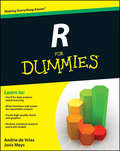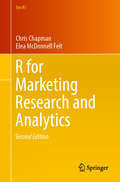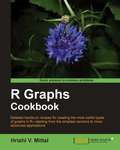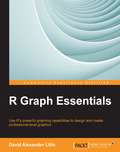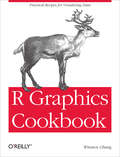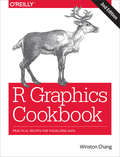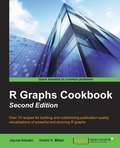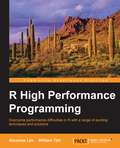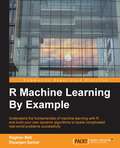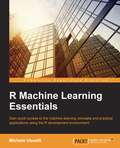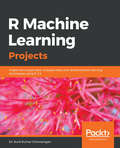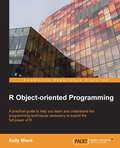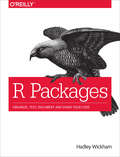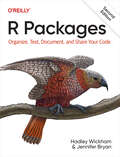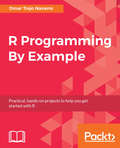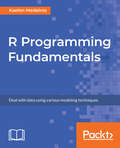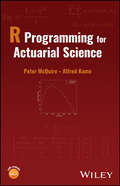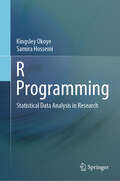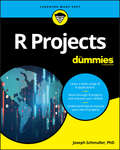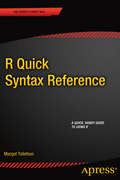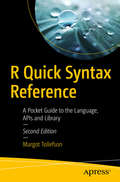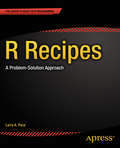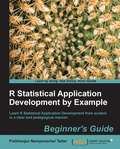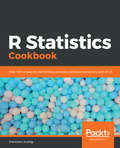- Table View
- List View
R For Dummies
by Joris Meys Andrie de VriesMaster the programming language of choice among statisticians and data analysts worldwide Coming to grips with R can be tough, even for seasoned statisticians and data analysts. Enter R For Dummies, the quick, easy way to master all the R you'll ever need. Requiring no prior programming experience and packed with practical examples, easy, step-by-step exercises, and sample code, this extremely accessible guide is the ideal introduction to R for complete beginners. It also covers many concepts that intermediate-level programmers will find extremely useful. Master your R ABCs ? get up to speed in no time with the basics, from installing and configuring R to writing simple scripts and performing simultaneous calculations on many variables Put data in its place ? get to know your way around lists, data frames, and other R data structures while learning to interact with other programs, such as Microsoft Excel Make data dance to your tune ? learn how to reshape and manipulate data, merge data sets, split and combine data, perform calculations on vectors and arrays, and much more Visualize it ? learn to use R's powerful data visualization features to create beautiful and informative graphical presentations of your data Get statistical ? find out how to do simple statistical analysis, summarize your variables, and conduct classic statistical tests, such as t-tests Expand and customize R ? get the lowdown on how to find, install, and make the most of add-on packages created by the global R community for a wide variety of purposes Open the book and find: Help downloading, installing, and configuring R Tips for getting data in and out of R Ways to use data frames and lists to organize data How to manipulate and process data Advice on fitting regression models and ANOVA Helpful hints for working with graphics How to code in R What R mailing lists and forums can do for you
R For Marketing Research and Analytics (Use R!)
by Chris Chapman Elea McDonnell FeitThe 2nd edition of R for Marketing Research and Analytics continues to be the best place to learn R for marketing research. This book is a complete introduction to the power of R for marketing research practitioners. The text describes statistical models from a conceptual point of view with a minimal amount of mathematics, presuming only an introductory knowledge of statistics. Hands-on chapters accelerate the learning curve by asking readers to interact with R from the beginning. Core topics include the R language, basic statistics, linear modeling, and data visualization, which is presented throughout as an integral part of analysis.Later chapters cover more advanced topics yet are intended to be approachable for all analysts. These sections examine logistic regression, customer segmentation, hierarchical linear modeling, market basket analysis, structural equation modeling, and conjoint analysis in R. The text uniquely presents Bayesian models with a minimally complex approach, demonstrating and explaining Bayesian methods alongside traditional analyses for analysis of variance, linear models, and metric and choice-based conjoint analysis. With its emphasis on data visualization, model assessment, and development of statistical intuition, this book provides guidance for any analyst looking to develop or improve skills in R for marketing applications.The 2nd edition increases the book’s utility for students and instructors with the inclusion of exercises and classroom slides. At the same time, it retains all of the features that make it a vital resource for practitioners: non-mathematical exposition, examples modeled on real world marketing problems, intuitive guidance on research methods, and immediately applicable code.
R Graph Cookbook
by Hrishi V. MittalThis hands-on guide cuts short the preamble and gets straight to the point - actually creating graphs, instead of just theoretical learning. Each recipe is specifically tailored to fulfill your appetite for visually representing you data in the best way possible. This book is for readers already familiar with the basics of R who want to learn the best techniques and code to create graphics in R in the best way possible. It will also serve as an invaluable reference book for expert R users.
R Graph Essentials
by David Alexander LillisThis book is targeted at R programmers who want to learn the graphing capabilities of R. This book will presume that you have working knowledge of R.
R Graphics Cookbook: Practical Recipes for Visualizing Data
by Winston ChangThis practical guide provides more than 150 recipes to help you generate high-quality graphs quickly, without having to comb through all the details of R’s graphing systems. Each recipe tackles a specific problem with a solution you can apply to your own project, and includes a discussion of how and why the recipe works.Most of the recipes use the ggplot2 package, a powerful and flexible way to make graphs in R. If you have a basic understanding of the R language, you’re ready to get started.Use R’s default graphics for quick exploration of dataCreate a variety of bar graphs, line graphs, and scatter plotsSummarize data distributions with histograms, density curves, box plots, and other examplesProvide annotations to help viewers interpret dataControl the overall appearance of graphicsRender data groups alongside each other for easy comparisonUse colors in plotsCreate network graphs, heat maps, and 3D scatter plotsStructure data for graphing
R Graphics Cookbook: Practical Recipes for Visualizing Data
by Winston ChangThis O’Reilly cookbook provides more than 150 recipes to help scientists, engineers, programmers, and data analysts generate high-quality graphs quickly—without having to comb through all the details of R’s graphing systems. Each recipe tackles a specific problem with a solution you can apply to your own project and includes a discussion of how and why the recipe works.Most of the recipes in this second edition use the updated version of the ggplot2 package, a powerful and flexible way to make graphs in R. You’ll also find expanded content about the visual design of graphics. If you have at least a basic understanding of the R language, you’re ready to get started with this easy-to-use reference.Use R’s default graphics for quick exploration of dataCreate a variety of bar graphs, line graphs, and scatter plotsSummarize data distributions with histograms, density curves, box plots, and moreProvide annotations to help viewers interpret dataControl the overall appearance of graphicsExplore options for using colors in plotsCreate network graphs, heat maps, and 3D scatter plotsGet your data into shape using packages from the tidyverse
R Graphics, Third Edition (Chapman & Hall/CRC The R Series)
by Paul MurrellThis third edition of Paul Murrell’s classic book on using R for graphics represents a major update, with a complete overhaul in focus and scope. It focuses primarily on the two core graphics packages in R - graphics and grid - and has a new section on integrating graphics. This section includes three new chapters: importing external images in to R; integrating the graphics and grid systems; and advanced SVG graphics.The emphasis in this third edition is on having the ability to produce detailed and customised graphics in a wide variety of formats, on being able to share and reuse those graphics, and on being able to integrate graphics from multiple systems.This book is aimed at all levels of R users. For people who are new to R, this book provides an overview of the graphics facilities, which is useful for understanding what to expect from R's graphics functions and how to modify or add to the output they produce. For intermediate-level R users, this book provides all of the information necessary to perform sophisticated customizations of plots produced in R. For advanced R users, this book contains vital information for producing coherent, reusable, and extensible graphics functions.
R Graphs Cookbook Second Edition
by Jaynal Abedin Hrishi V. MittalTargeted at those with an existing familiarity with R programming, this practical guide will appeal directly to programmers interested in learning effective data visualization techniques with R and a wide-range of its associated libraries.
R High Performance Programming
by William Tjhi Aloysius LimThis book is for programmers and developers who want to improve the performance of their R programs by making them run faster with large data sets or who are trying to solve a pesky performance problem.
R Machine Learning By Example
by Raghav Bali Dipanjan SarkarUnderstand the fundamentals of machine learning with R and build your own dynamic algorithms to tackle complicated real-world problems successfully About This Book * Get to grips with the concepts of machine learning through exciting real-world examples * Visualize and solve complex problems by using power-packed R constructs and its robust packages for machine learning * Learn to build your own machine learning system with this example-based practical guide Who This Book Is For If you are interested in mining useful information from data using state-of-the-art techniques to make data-driven decisions, this is a go-to guide for you. No prior experience with data science is required, although basic knowledge of R is highly desirable. Prior knowledge in machine learning would be helpful but is not necessary. What You Will Learn * Utilize the power of R to handle data extraction, manipulation, and exploration techniques * Use R to visualize data spread across multiple dimensions and extract useful features * Explore the underlying mathematical and logical concepts that drive machine learning algorithms * Dive deep into the world of analytics to predict situations correctly * Implement R machine learning algorithms from scratch and be amazed to see the algorithms in action * Write reusable code and build complete machine learning systems from the ground up * Solve interesting real-world problems using machine learning and R as the journey unfolds * Harness the power of robust and optimized R packages to work on projects that solve real-world problems in machine learning and data science In Detail Data science and machine learning are some of the top buzzwords in the technical world today. From retail stores to Fortune 500 companies, everyone is working hard to making machine learning give them data-driven insights to grow their business. With powerful data manipulation features, machine learning packages, and an active developer community, R empowers users to build sophisticated machine learning systems to solve real-world data problems. This book takes you on a data-driven journey that starts with the very basics of R and machine learning and gradually builds upon the concepts to work on projects that tackle real-world problems. You'll begin by getting an understanding of the core concepts and definitions required to appreciate machine learning algorithms and concepts. Building upon the basics, you will then work on three different projects to apply the concepts of machine learning, following current trends and cover major algorithms as well as popular R packages in detail. These projects have been neatly divided into six different chapters covering the worlds of e-commerce, finance, and social-media, which are at the very core of this data-driven revolution. Each of the projects will help you to understand, explore, visualize, and derive insights depending upon the domain and algorithms. Through this book, you will learn to apply the concepts of machine learning to deal with data-related problems and solve them using the powerful yet simple language, R. Style and approach The book is an enticing journey that starts from the very basics to gradually pick up pace as the story unfolds. Each concept is first defined in the larger context of things succinctly, followed by a detailed explanation of their application. Each topic is explained with the help of a project that solves a real real-world problem involving hands-on work thus giving you a deep insight into the world of machine learning.
R Machine Learning Essentials
by Michele UsuelliIf you want to learn how to develop effective machine learning solutions to your business problems in R, this book is for you. It would be helpful to have a bit of familiarity with basic object-oriented programming concepts, but no prior experience is required.
R Machine Learning Projects: Implement Supervised, Unsupervised, And Reinforcement Learning Techniques Using R 3. 5
by Sunil Kumar ChinnamgariThis book is for data analysts, data scientists, and machine learning developers who wish to master the machine learning concepts using R by building real-world projects. Each project will help you test your expertise to implement the working mechanism of machine learning algorithms and techniques. A basic understanding of machine learning and working knowledge of R programming is a must.
R Object-oriented Programming
by Kelly BlackThis book is designed for people with some experience in basic programming practices. It is also assumed that they have some basic experience using R and are familiar using the command line in an R environment. Our primary goal is to raise a beginner to a more advanced level to make him/her more comfortable creating programs and extending R to solve common problems.
R Packages
by Hadley WickhamTurn your R code into packages that others can easily download and use. This practical book shows you how to bundle reusable R functions, sample data, and documentation together by applying author Hadley Wickham's package development philosophy. In the process, you'll work with devtools, roxygen, and testthat, a set of R packages that automate common development tasks. Devtools encapsulates best practices that Hadley has learned from years of working with this programming language.Ideal for developers, data scientists, and programmers with various backgrounds, this book starts you with the basics and shows you how to improve your package writing over time. You'll learn to focus on what you want your package to do, rather than think about package structure.Learn about the most useful components of an R package, including vignettes and unit testsAutomate anything you can, taking advantage of the years of development experience embodied in devtoolsGet tips on good style, such as organizing functions into filesStreamline your development process with devtoolsLearn the best way to submit your package to the Comprehensive R Archive Network (CRAN)Learn from a well-respected member of the R community who created 30 R packages, including ggplot2, dplyr, and tidyr
R Packages: Organize, Test, Document, and Share Your Code
by Jennifer Bryan Hadley WickhamTurn your R code into packages that others can easily install and use. With this fully updated edition, developers and data scientists will learn how to bundle reusable R functions, sample data, and documentation together by applying the package development philosophy used by the team that maintains the "tidyverse" suite of packages. In the process, you'll learn how to automate common development tasks using a set of R packages, including devtools, usethis, testthat, and roxygen2.Authors Hadley Wickham and Jennifer Bryan from Posit (formerly known as RStudio) help you create packages quickly, then teach you how to get better over time. You'll be able to focus on what you want your package to do as you progressively develop greater mastery of the structure of a package.With this book, you will:Learn the key components of an R package, including code, documentation, and testsStreamline your development process with devtools and the RStudio IDEGet tips on effective habits such as organizing functions into filesGet caught up on important new features in the devtools ecosystemLearn about the art and science of unit testing, using features in the third edition of testthatTurn your existing documentation into a beautiful and user friendly website with pkgdownGain an appreciation of the benefits of modern code hosting platforms, such as GitHub
R Programming By Example: Practical, hands-on projects to help you get started with R
by Omar Trejo Peter C. FigliozziKey Features Get a firm hold on the fundamentals of R through practical hands-on examples Get started with good R programming fundamentals for data science Exploit the different libraries of R to build interesting applications in R Book Description R is a high-level statistical language and is widely used among statisticians and data miners to develop analytical applications. Often, data analysis people with great analytical skills lack solid programming knowledge and are unfamiliar with the correct ways to use R. Based on the version 3.4, this book will help you develop strong fundamentals when working with R by taking you through a series of full representative examples, giving you a holistic view of R. We begin with the basic installation and configuration of the R environment. As you progress through the exercises, you'll become thoroughly acquainted with R's features and its packages. With this book, you will learn about the basic concepts of R programming, work efficiently with graphs, create publication-ready and interactive 3D graphs, and gain a better understanding of the data at hand. The detailed step-by-step instructions will enable you to get a clean set of data, produce good visualizations, and create reports for the results. It also teaches you various methods to perform code profiling and performance enhancement with good programming practices, delegation, and parallelization. By the end of this book, you will know how to efficiently work with data, create quality visualizations and reports, and develop code that is modular, expressive, and maintainable. What you will learn Discover techniques to leverage R’s features, and work with packages Perform a descriptive analysis and work with statistical models using R Work efficiently with objects without using loops Create diverse visualizations to gain better understanding of the data Understand ways to produce good visualizations and create reports for the results Read and write data from relational databases and REST APIs, both packaged and unpackaged Improve performance by writing better code, delegating that code to a more efficient programming language, or making it parallel
R Programming Fundamentals: Deal with data using various modeling techniques
by Kaelen MedeirosStudy data analysis and visualization to successfully analyze data with RKey FeaturesGet to grips with data cleaning methodsExplore statistical concepts and programming in R, including best practicesBuild a data science project with real-world examplesBook DescriptionR Programming Fundamentals, focused on R and the R ecosystem, introduces you to the tools for working with data. To start with, you’ll understand you how to set up R and RStudio, followed by exploring R packages, functions, data structures, control flow, and loops.Once you have grasped the basics, you’ll move on to studying data visualization and graphics. You’ll learn how to build statistical and advanced plots using the powerful ggplot2 library. In addition to this, you’ll discover data management concepts such as factoring, pivoting, aggregating, merging, and dealing with missing values.By the end of this book, you’ll have completed an entire data science project of your own for your portfolio or blog.What you will learnUse basic programming concepts of R such as loading packages, arithmetic functions, data structures, and flow controlImport data to R from various formats such as CSV, Excel, and SQLClean data by handling missing values and standardizing fieldsPerform univariate and bivariate analysis using ggplot2Create statistical summary and advanced plots such as histograms, scatter plots, box plots, and interaction plotsApply data management techniques, such as factoring, pivoting, aggregating, merging, and dealing with missing values, on the example datasetsWho this book is forR Programming Fundamentals is for you if you are an analyst who wants to grow in the field of data science and explore the latest tools.
R Programming for Actuarial Science
by Peter McQuire Alfred KumeR Programming for Actuarial Science Professional resource providing an introduction to R coding for actuarial and financial mathematics applications, with real-life examples R Programming for Actuarial Science provides a grounding in R programming applied to the mathematical and statistical methods that are of relevance for actuarial work. In R Programming for Actuarial Science, readers will find: Basic theory for each chapter to complement other actuarial textbooks which provide foundational theory in depth. Topics covered include compound interest, statistical inference, asset-liability matching, time series, loss distributions, contingencies, mortality models, and option pricing plus many more typically covered in university courses. More than 400 coding examples and exercises, most with solutions, to enable students to gain a better understanding of underlying mathematical and statistical principles. An overall basic to intermediate level of coverage in respect of numerous actuarial applications, and real-life examples included with every topic. Providing a highly useful combination of practical discussion and basic theory, R Programming for Actuarial Science is an essential reference for BSc/MSc students in actuarial science, trainee actuaries studying privately, and qualified actuaries with little programming experience, along with undergraduate students studying finance, business, and economics.
R Programming: Statistical Data Analysis in Research
by Samira Hosseini Kingsley OkoyeThis book is written for statisticians, data analysts, programmers, researchers, professionals, and general consumers on how to perform different types of statistical data analysis for research purposes using R object-oriented programming language and RStudio integrated development environment (IDE). R is an open-source software with a development environment (RStudio) for computing statistics and graphical displays through data manipulation, modeling, and calculation. R packages and supported libraries provide a wide range of functions for programming and analyzing of data. Unlike many of the existing statistical software, R has the added benefit of allowing the users to write more efficient codes by using command-line scripting and vectors. It has several built-in functions and libraries that are extensible and allows the users to define their own (customized) functions on how they expect the program to behave while handling the data, which can also be stored in the simple object system. Therefore, this book serves as both textbook and manual for R statistics particularly in academic research, data analytics, and computer programming targeted to help inform and guide the work of the users. It provides information about different types of statistical data analysis and methods, and the best scenarios for use of each case in R. It gives a hands-on step-by-step practical guide on how to identify and conduct the different parametric and nonparametric procedures. This includes a description of the different conditions or assumptions that are necessary for performing the various statistical methods or tests, and how to understand the results of the methods. The book also covers the different data formats and sources, and how to test for the reliability and validity of the available datasets. Different research experiments, case scenarios, and examples are explained in this book. The book provides a comprehensive description and step-by-step practical hands-on guide to carrying out the different types of statistical analysis in R particularly for research purposes with examples. Ranging from how to import and store datasets in R as objects, how to code and call the methods or functions for manipulating the datasets or objects, factorization, and vectorization, to better reasoning, interpretation, and storage of the results for future use, and graphical visualizations and representations thus congruence of Statistics and Computer programming in Research.
R Projects For Dummies
by Joseph SchmullerMake the most of R’s extensive toolset R Projects For Dummies offers a unique learn-by-doing approach. You will increase the depth and breadth of your R skillset by completing a wide variety of projects. By using R’s graphics, interactive, and machine learning tools, you’ll learn to apply R’s extensive capabilities in an array of scenarios. The depth of the project experience is unmatched by any other content online or in print. And you just might increase your statistics knowledge along the way, too! R is a free tool, and it’s the basis of a huge amount of work in data science. It's taking the place of costly statistical software that sometimes takes a long time to learn. One reason is that you can use just a few R commands to create sophisticated analyses. Another is that easy-to-learn R graphics enable you make the results of those analyses available to a wide audience. This book will help you sharpen your skills by applying them in the context of projects with R, including dashboards, image processing, data reduction, mapping, and more. Appropriate for R users at all levels Helps R programmers plan and complete their own projects Focuses on R functions and packages Shows how to carry out complex analyses by just entering a few commands If you’re brand new to R or just want to brush up on your skills, R Projects For Dummies will help you complete your projects with ease.
R Quick Syntax Reference
by Margot TollefsonTheR Quick Syntax Referenceis a handy reference book detailing the intricacies of the R language. Not only is R a free, open-source tool, R is powerful, flexible, and has state of the art statistical techniques available. With the many details which must be correct when using any language, however, the R Quick Syntax Reference makes using R easier. Starting with the basic structure of R, the book takes you on a journey through the terminology used in R and the syntax required to make R work. You will find looking up the correct form for an expression quick and easy. With a copy of the R Quick Syntax Reference in hand, you will find that are able to use the multitude of functions availableto the R user and are even able to write your own functions to explore and analyze data. Takes you through learning R, from download to statistical analysis. Clears the confusion around object types and how to use and convert the types. Tells you how to search for statistical techniques using the R help pages. What you'll learn Download R and R packages for your platform. Work with R within your file structure. Enter data from the keyboard and from external files. Determine and assign modes, classes, and types of objects Do calculations using the computational tools in R. Use R functions and create new functions. Who this book is for TheR Quick Syntax Referenceis for statisticians and other data analysts who are starting to use the R language. It is also for veteran R users who want a quick reference to the language. The book is an excellent choice for the busy data scientist who likes to experiment with new ways of analysis and who needs the flexibility of the data editing available in R. Table of Contents Downloading R and Setting R Up in a File SystemThe R PromptAssignments and OperatorsModes of ObjectsThe Classes and TypesPackaged FunctionsUser Defined FunctionsHow to Use a Function Inputting or Creating Data Outputting Data and Output Manipulating Objects Flow Conditioners Condition Based Functions Some Examples of Conditioning Some Common Functions The Packages base, stats, and graphics Tricks of the Trade"
R Quick Syntax Reference: A Pocket Guide to the Language, APIs and Library
by Margot TollefsonThis handy reference book detailing the intricacies of R updates the popular first edition by adding R version 3.4 and 3.5 features. Starting with the basic structure of R, the book takes you on a journey through the terminology used in R and the syntax required to make R work. You will find looking up the correct form for an expression quick and easy. Some of the new material includes information on RStudio, S4 syntax, working with character strings, and an example using the Twitter API.With a copy of the R Quick Syntax Reference in hand, you will find that you are able to use the multitude of functions available in R and are even able to write your own functions to explore and analyze data.What You Will LearnDiscover the modes and classes of R objects and how to use themUse both packaged and user-created functions in R Import/export data and create new data objects in RCreate descriptive functions and manipulate objects in RTake advantage of flow control and conditional statementsWork with packages such as base, stats, and graphicsWho This Book Is ForThose with programming experience, either new to R, or those with at least some exposure to R but who are new to the latest version.
R Recipes
by Larry A. PaceR Recipes is your handy problem-solution reference for learning and using the popular R programming language for statistics and other numerical analysis. Packed with hundreds of code and visual recipes, this book helps you to quickly learn the fundamentals and explore the frontiers of programming, analyzing and using R. R Recipes provides textual and visual recipes for easy and productive templates for use and re-use in your day-to-day R programming and data analysis practice. Whether you're in finance, cloud computing, big or small data analytics, or other applied computational and data science - R Recipes should be a staple for your code reference library.
R Statistical Application Development by Example Beginner's Guide
by Prabhanjan Narayanachar TattarFull of screenshots and examples, this Beginner's Guide by Example will teach you practically everything you need to know about R statistical application development from scratch. You will begin learning the first concepts of statistics in R which is vital in this fast paced era and it is also a bargain as you do not need to do a preliminary course on the subject.
R Statistics Cookbook: Over 100 recipes for performing complex statistical operations with R 3.5
by Francisco JuretigSolve real-world statistical problems using the most popular R packages and techniques Key Features Learn how to apply statistical methods to your everyday research with handy recipes Foster your analytical skills and interpret research across industries and business verticals Perform t-tests, chi-squared tests, and regression analysis using modern statistical techniques Book Description R is a popular programming language for developing statistical software. This book will be a useful guide to solving common and not-so-common challenges in statistics. With this book, you'll be equipped to confidently perform essential statistical procedures across your organization with the help of cutting-edge statistical tools. You'll start by implementing data modeling, data analysis, and machine learning to solve real-world problems. You'll then understand how to work with nonparametric methods, mixed effects models, and hidden Markov models. This book contains recipes that will guide you in performing univariate and multivariate hypothesis tests, several regression techniques, and using robust techniques to minimize the impact of outliers in data.You'll also learn how to use the caret package for performing machine learning in R. Furthermore, this book will help you understand how to interpret charts and plots to get insights for better decision making. By the end of this book, you will be able to apply your skills to statistical computations using R 3.5. You will also become well-versed with a wide array of statistical techniques in R that are extensively used in the data science industry. What you will learn Become well versed with recipes that will help you interpret plots with R Formulate advanced statistical models in R to understand its concepts Perform Bayesian regression to predict models and input missing data Use time series analysis for modelling and forecasting temporal data Implement a range of regression techniques for efficient data modelling Get to grips with robust statistics and hidden Markov models Explore ANOVA (Analysis of Variance) and perform hypothesis testing Who this book is for If you are a quantitative researcher, statistician, data analyst, or data scientist looking to tackle various challenges in statistics, this book is what you need! Proficiency in R programming and basic knowledge of linear algebra is necessary to follow along the recipes covered in this book.
